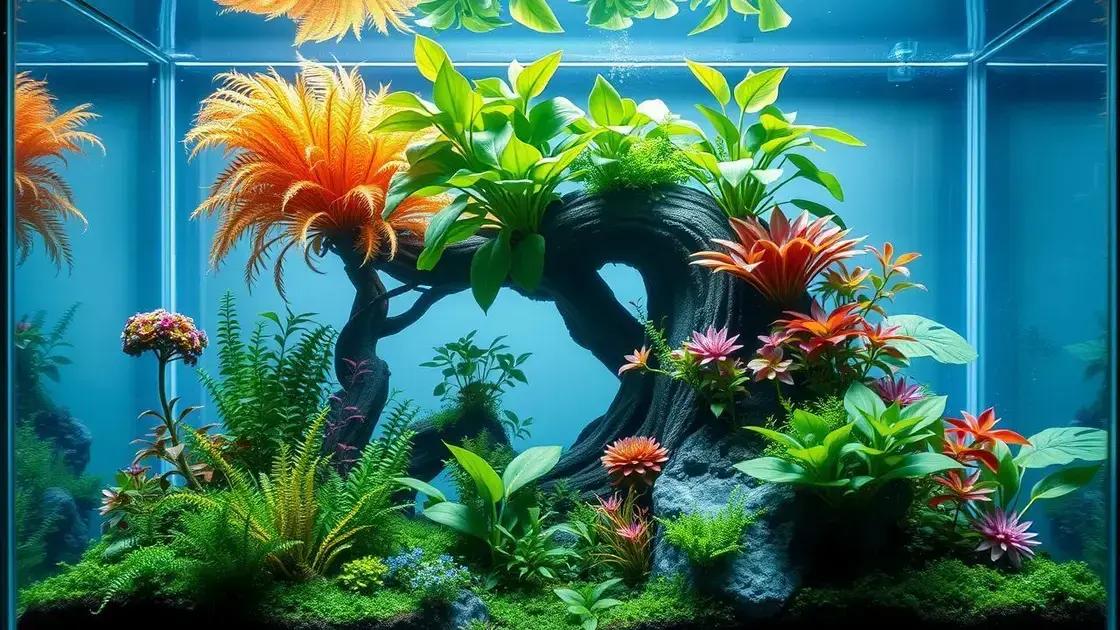How to Care for Plants in Your Aquarium: 7 Essential Tips for Beginners
How to care for plants in aquarium is more than just a question for novice aquarium owners. It’s about creating a lush, thriving aquatic ecosystem that enhances the beauty of your home. The right combination of light, nutrients, and plant selection can transform your aquarium into a vibrant underwater garden. Dive in to learn how to maximize growth and health for your aquatic plants.
Table of Contents
ToggleChoosing the right plants for your aquarium
Choosing the right plants for your aquarium is crucial for creating a healthy aquatic environment. Selecting suitable aquatic plants can enhance the aesthetic appeal and overall well-being of your fish. Start by considering the specific needs of your aquarium, such as size, lighting, and water parameters.
Factors to consider in your selection
- Species compatibility: Ensure that the plants you choose are compatible with your fish species.
- Light requirements: Different plants have varying light needs, so select according to your aquarium lighting setup.
- Growth rate: Fast-growing plants can help stabilize water parameters, but may require frequent trimming.
- Maintenance level: Opt for low-maintenance plants if you’re a beginner.
Popular aquatic plants for your aquarium
- Anubias: Ideal for beginners, tolerates low light.
- Java fern: Low maintenance and versatile, grows well in various conditions.
- Amazon sword: Provides excellent cover and is great for mid-ground placement.
- Cryptocoryne: Hardy and adaptable, perfect for different tank setups.
- Water wisteria: Fast-growing, excellent for improving water quality.
Caring for your aquatic plants
Once you have selected the right plants for your aquarium, understanding their care is essential. This includes providing the correct substrate, ensuring proper fertilization, and maintaining optimal water parameters.
Explore indoor gardening techniques to learn more about the proper care for aquatic plants.
Common questions about plant selection
- What are the best plants for a beginner aquarium? Anubias and Java fern are excellent starting choices.
- How often should I trim my aquarium plants? Typically, every 2-4 weeks depending on growth rates.
Conclusion
By thoughtfully choosing the right plants for your aquarium, you create a thriving environment for both fish and flora. Always research and match your plant selections to your aquarium’s conditions for the best results.
Tips for maintaining water quality

Tips for maintaining water quality in your aquarium are essential for the health of both plants and fish. Healthy water quality ensures that your aquatic plants thrive and can properly absorb nutrients. Begin by regularly monitoring water parameters, including pH, ammonia, nitrite, and nitrate levels.
Key parameters to monitor
- pH: Ideally between 6.5 and 7.5 for most aquatic plants.
- Ammonia: Should be at 0 ppm, as even low levels can be toxic.
- Nitrite: Also should be at 0 ppm to avoid harming fish.
- Nitrate: Levels should be below 40 ppm for healthy growth.
Best practices for water quality management
- Regular water changes: Change 10-15% of the water weekly to reduce toxins.
- Use a quality filter: Invest in a good filtration system to keep the water clean.
- Test regularly: Use water testing kits to keep an eye on water quality parameters.
- Avoid overfeeding: This can lead to excess waste and ammonia spikes.
- Control algae growth: Implement methods to prevent algae, which can disrupt water quality.
Understanding the nitrogen cycle
Maintaining water quality is closely tied to the nitrogen cycle in your aquarium. This process helps break down waste products and convert them into less harmful substances. To better manage your aquarium’s ecosystem, familiarize yourself with the nitrogen cycle and how it affects both water quality and plant health. For more on this, consider exploring indoor gardening techniques.
Common questions about water quality
- How often should I test my aquarium water? At least once a week is advisable, especially for new setups.
- What can I do to lower nitrate levels? Perform water changes and consider adding live plants, which absorb nitrates.
Conclusion
By applying these tips for maintaining water quality, you can create an ideal environment for your aquatic plants and fish, promoting a vibrant and healthy aquarium.
Essential lighting techniques for aquatic plants
Essential lighting techniques for aquatic plants play a crucial role in their growth and health. Proper lighting not only enhances the beauty of your aquarium but also supports the photosynthesis process vital for aquatic plants. It’s important to choose the right type of light and understand its significance for plant development.
Types of lighting for your aquarium
- LED lights: Energy-efficient and long-lasting; ideal for all plant types.
- Fluorescent lights: Common and inexpensive, suitable for moderate light plants.
- Metal halide lights: Provide intense light for high-light demanding plants but consume more energy.
- Incandescent bulbs: Generally not recommended due to high heat emission and low efficiency.
Light duration and intensity
Understanding how much light your aquarium plants need is essential for their health. Here are some guidelines:
- Light duration: Keep lights on for 8-12 hours daily to simulate natural daylight.
- Intensity: Adjust light intensity based on plant needs; low-light plants need less, while high-light plants thrive with more.
- Photoperiod: Maintain a consistent light schedule to mimic seasonal changes for better growth.
Positioning your aquarium lights
How you position your lights can also impact plant growth. Aim for even light distribution across the tank to avoid shadowed areas.
- Angle: Position lights to avoid direct glare and evenly distribute light.
- Height: Adjust the height of the light above the water surface based on the type of plants you have.
- Reflectors: Use reflectors to enhance light utilization and increase overall brightness in the aquarium.
Further resources on aquatic plant care
For more information on the intricacies of aquatic plant care, including lighting techniques, consider exploring indoor gardening techniques.
Common questions about aquarium lighting
- How do I know if my plants are getting enough light? Look for healthy growth and vibrant colors; yellowing leaves may indicate insufficient light.
- Can too much light harm aquatic plants? Yes, excessive light can lead to algae growth and stress on the plants.
Conclusion
By mastering these essential lighting techniques for aquatic plants, you set the stage for a thriving aquarium ecosystem that supports both plant and fish health.
In conclusion
Caring for aquatic plants requires a solid understanding of various key factors, including proper plant selection, water quality maintenance, and effective lighting techniques. By implementing the tips and techniques discussed, you can create a thriving aquarium environment that supports both your plants and fish. Remember that a healthy aquarium is an ecosystem, where each component plays a vital role. To further enhance your indoor gardening skills, consider exploring additional resources, such as tips on enhancing your indoor garden.

